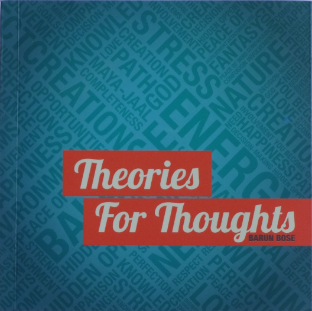Theories for Thought by Barun Bose
Oct 11, 2019, 11 31 | Updated: Oct 11, 2019, 11 31
"Theories for Thoughts is a set of musings in which I have presented for readers, to contemplate, analyse and to draw conclusions. It is not necessary to agree or to disagree with my views - as long as it makes the readers think, question or challenge the theories which I propose. This process will go a long way in preparing a person for the many challenges one faces in life. Preparedness in accepting these challenges is the key to happiness and success in life," says Barun Bose, author of Theories for Thoughts.
The book is an effort to initiate the reader to a process of analysis, which may lead to forming their own perceptions and drawing separate conclusions. Bose calls this process ‘owning the knowledge’. He believes that their ‘own’ knowledge and perception will give readers more confidence and courage to pursue their goals.
What is the philosophy behind Theories for Thoughts?
Man lives in a society. A society is dominated by following a series of systems. Two major institutions, namely – the government and religion, have developed these systems.
The government controls the system through rules, regulations and laws to provide the basic needs of food, clothes, shelter and security. The system developed by religion is defined in scriptures, prayer, preaching and discourses. It provides spiritual development for peace and happiness within a society.
The guidelines provided by both religion and government are based upon the truth, in one half, and what is believed to be the truth, in another. The latter is known as beliefs.
Can you elaborate on your understanding of these ‘beliefs?’
Beliefs are made up of what’s true and false. Truth does not give us stress, whereas, that which is false, does. Therefore, beliefs are liable to develop stress in our behaviour.
This is the reason that mankind is in constant search for truth. The higher the ratio of truth in our beliefs, the more the happiness one attains. This truth is derived through knowledge, analysis and imagination. It is a thinking process, which helps us to find the truth.
What is the purpose of the book?
This book is an attempt to ignite the reader’s thoughts, to seek the truth in various beliefs that we follow. It presents semi-formed thoughts, so the reader can derive his or her own conclusions. The readers can then find truth in their own beliefs and have fewer conflicts in their lives.
My previous book “Do Not Fear” dealt with the inner self and a path to find it through spiritualism. This book gives a more scientific approach and challenges my readers to choose a path that they are comfortable with.
Mankind endeavours to satisfy their needs right from birth. While physical needs like food, shelter and clothing are satisfied through activity, psychological needs thrives on recognition, power, achievement and love. These are further acquired through the application of knowledge.
Can you elaborate on your perception of ‘knowledge?’
People try to acquire greater knowledge to satisfy their ever-changing needs. However, raw knowledge, in the form of information or data, other than satisfying an immediate curiosity, is not sufficiently useful to meet our needs. This information needs to be analysed to be useful to our efforts.
Saints, preachers, philosophers and so on, churned and sifted this information to understand the environment and its activities. It is only then they were enlightened that they could show us paths to growth, happiness and peace. It is the analysis of this information that brings true knowledge, which provides answers to our efforts. Failure to analyse a piece of knowledge makes its application almost useless. Our ‘own’ knowledge and perception gives us more confidence and courage to pursue our goals. Because we use our ‘own’ knowledge, it helps us recognize and accept our failures, and motivates us to try a different approach.
Analysis, therefore, is an important aspect of our gaining knowledge and for our preparation to make our life successful. For analysis, we require matter – the “stuff” to analyse, so that we can draw conclusions to adopt them for our guidance.
When a reader closes Theories for Thoughts, what reaction is one to expect?
In this book I have presented few thoughts for the readers, to analyse and to draw conclusions. It is not necessary to agree or to disagree with my views - as long as it makes the readers to think about, question or challenge the theories given. Hence, the title for the book, ‘Theories for Thoughts”.
This will inculcate the habit of discussion, debate and dissent – a process for analysis, which may lead to the readers forming their own perceptions and drawing separate conclusions. I have named this process as ‘owning the knowledge’.
Preparedness in accepting our faults and to make renewed efforts is the key to success. In this book I have made an effort to initiate the reader to analyse his thoughts to prepare the reader for the challenges that life has to offer. The reader can then solve his or her problems, find the path to success, and may even guide others to success. This was my purpose of writing this book, and I do hope that it will be useful to my readers.
.........................................
About the author
 Barun Bose is a graduate in Mechanical Engineering from Banaras Hindu University (1954). He joined the Indian Air Force as a Commissioned Officer in the Technical Branch. He was selected to join the core team for establishing the MIG-21 manufacturing complex in Nashik, Maharashtra. He sidestepped from the IAF to join the Hindustan Aeronautics Ltd (HAL), where he joined the DGM (Department of Mechanical Engineering), HAL Kanpur Division and DGM of Helicopter Division in Bangalore.
Barun Bose is a graduate in Mechanical Engineering from Banaras Hindu University (1954). He joined the Indian Air Force as a Commissioned Officer in the Technical Branch. He was selected to join the core team for establishing the MIG-21 manufacturing complex in Nashik, Maharashtra. He sidestepped from the IAF to join the Hindustan Aeronautics Ltd (HAL), where he joined the DGM (Department of Mechanical Engineering), HAL Kanpur Division and DGM of Helicopter Division in Bangalore.
During the latter part of his tenure in HAL, he developed a keen interest in management training. After finishing his engagement with HAL in 1991, he has been delivering MBA lectures in Christ College, Kanpur University, Kanpur Agricultural University and IIT Kanpur.
During his twenty-five years of teaching, it occurred to him that there was a lack of confidence and growing confusion among the young to tackle the future. He authored his first book Do Not Fear in 2012 to give some ideas to the young generation to look through the mesh of confusion, the bright future of knowledge, health, divinity, success, happiness and peace.
His second book Theories for Thoughts is more of a reflection on various aspects of life and is a general read which. It was released at Gangaram’s Book Bureau, on 8 August 2013.







